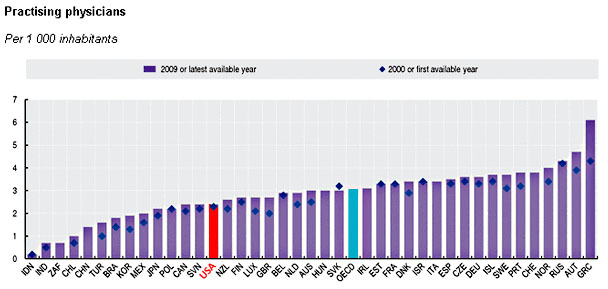Conservatives have picked up today on a Kaiser Health News piece reporting on doctor complaints that insurers plan to pay them less for Obamacare patients than for other patients:
Insurance officials acknowledge they have reduced rates in some plans, saying they are under enormous pressure to keep premiums affordable. They say physicians will make up for the lower pay by seeing more patients, since the plans tend to have smaller networks of doctors. But many primary care doctors say they barely have time to take care of the patients they have now.
Matt Yglesias is unsympathetic. He says American doctors are very well paid and should quit griping: “If we ever reach the point where American doctors have been squeezed so badly that they start fleeing north of the border to get higher pay in Canada, then we’ve squeezed too hard. Until that happens, forget about it.”
That’s pretty cold. But if you really want to know what’s going on, take a gander at the chart below. It’s from the OECD, so it includes all of the world’s relatively rich countries:

That’s damn peculiar, isn’t it? If Econ 101 is to be believed, higher pay should produce more doctors. And yet, even though the United States pays doctors far more than any other country on the globe, we’re in the bottom third. We have more doctors per capita than poorish countries like Mexico and Poland, but far fewer than Belgium and Britain and Germany—all of which pay doctors considerably less than we do here. So what’s going on?
As Matt says, the basic answer is that U.S. doctors operate as a cartel. They artificially limit their own ranks, which drives up their compensation:
What we really ought to be doing is working to further pressure the incomes of doctors through supply-side reforms. That means letting nurse-practitioners treat patients without kicking a slice upstairs to an M.D., letting more doctors immigrate to the United States, and it means opening more medical schools. Common sense says that since the population both grows and ages over time, there should be more people admitted to medical school today than were thirty years ago. But that’s not the case. Instead we produce roughly the same number of new doctors, admissions standards have gotten tougher, and doctors have become scarcer.
This is yet another reason not to shed too many tears for doctors. They’ve basically brought this on themselves. If the market were allowed to produce as many doctors as there’s demand for, they’d already be getting paid less. Right now they’re enjoying the substantial rents that come from squeezing their own supply, and they’ve fought like lemmings for decades to keep it that way. You can hardly blame them for that, but there’s no reason the rest of us should put up with it. It’s time to fight back.













